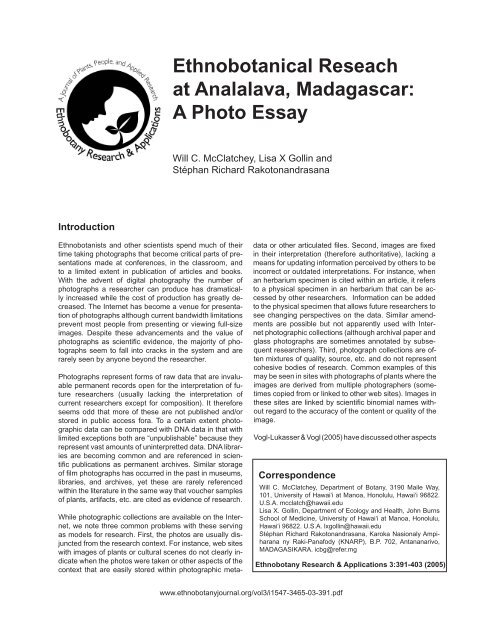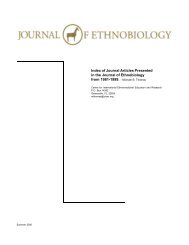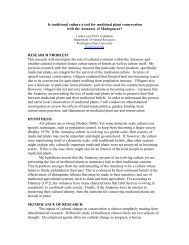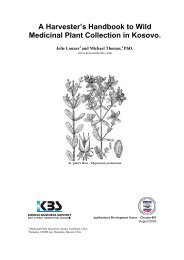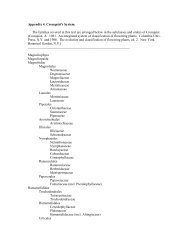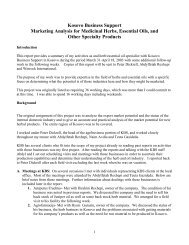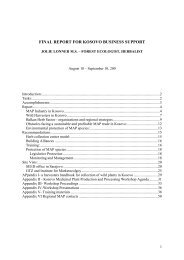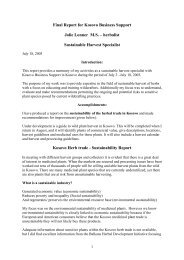Ethnobotanical Reseach at Analalava, Madagascar: A Photo Essay
Ethnobotanical Reseach at Analalava, Madagascar: A Photo Essay
Ethnobotanical Reseach at Analalava, Madagascar: A Photo Essay
Create successful ePaper yourself
Turn your PDF publications into a flip-book with our unique Google optimized e-Paper software.
<strong>Ethnobotanical</strong> <strong>Reseach</strong><br />
<strong>at</strong> <strong>Analalava</strong>, <strong>Madagascar</strong>:<br />
A <strong>Photo</strong> <strong>Essay</strong><br />
Will C. McCl<strong>at</strong>chey, Lisa X Gollin and<br />
Stéphan Richard Rakotonandrasana<br />
Introduction<br />
Ethnobotanists and other scientists spend much of their<br />
time taking photographs th<strong>at</strong> become critical parts of present<strong>at</strong>ions<br />
made <strong>at</strong> conferences, in the classroom, and<br />
to a limited extent in public<strong>at</strong>ion of articles and books.<br />
With the advent of digital photography the number of<br />
photographs a researcher can produce has dram<strong>at</strong>ically<br />
increased while the cost of production has gre<strong>at</strong>ly decreased.<br />
The Internet has become a venue for present<strong>at</strong>ion<br />
of photographs although current bandwidth limit<strong>at</strong>ions<br />
prevent most people from presenting or viewing full-size<br />
images. Despite these advancements and the value of<br />
photographs as scientific evidence, the majority of photographs<br />
seem to fall into cracks in the system and are<br />
rarely seen by anyone beyond the researcher.<br />
<strong>Photo</strong>graphs represent forms of raw d<strong>at</strong>a th<strong>at</strong> are invaluable<br />
permanent records open for the interpret<strong>at</strong>ion of future<br />
researchers (usually lacking the interpret<strong>at</strong>ion of<br />
current researchers except for composition). It therefore<br />
seems odd th<strong>at</strong> more of these are not published and/or<br />
stored in public access fora. To a certain extent photographic<br />
d<strong>at</strong>a can be compared with DNA d<strong>at</strong>a in th<strong>at</strong> with<br />
limited exceptions both are “unpublishable” because they<br />
represent vast amounts of uninterpretted d<strong>at</strong>a. DNA libraries<br />
are becoming common and are referenced in scientific<br />
public<strong>at</strong>ions as permanent archives. Similar storage<br />
of film photographs has occurred in the past in museums,<br />
libraries, and archives, yet these are rarely referenced<br />
within the liter<strong>at</strong>ure in the same way th<strong>at</strong> voucher samples<br />
of plants, artifacts, etc. are cited as evidence of research.<br />
While photographic collections are available on the Internet,<br />
we note three common problems with these serving<br />
as models for research. First, the photos are usually disjuncted<br />
from the research context. For instance, web sites<br />
with images of plants or cultural scenes do not clearly indic<strong>at</strong>e<br />
when the photos were taken or other aspects of the<br />
context th<strong>at</strong> are easily stored within photographic metad<strong>at</strong>a<br />
or other articul<strong>at</strong>ed files. Second, images are fixed<br />
in their interpret<strong>at</strong>ion (therefore authorit<strong>at</strong>ive), lacking a<br />
means for upd<strong>at</strong>ing inform<strong>at</strong>ion perceived by others to be<br />
incorrect or outd<strong>at</strong>ed interpret<strong>at</strong>ions. For instance, when<br />
an herbarium specimen is cited within an article, it refers<br />
to a physical specimen in an herbarium th<strong>at</strong> can be accessed<br />
by other researchers. Inform<strong>at</strong>ion can be added<br />
to the physical specimen th<strong>at</strong> allows future researchers to<br />
see changing perspectives on the d<strong>at</strong>a. Similar amendments<br />
are possible but not apparently used with Internet<br />
photographic collections (although archival paper and<br />
glass photographs are sometimes annot<strong>at</strong>ed by subsequent<br />
researchers). Third, photograph collections are often<br />
mixtures of quality, source, etc. and do not represent<br />
cohesive bodies of research. Common examples of this<br />
may be seen in sites with photographs of plants where the<br />
images are derived from multiple photographers (sometimes<br />
copied from or linked to other web sites). Images in<br />
these sites are linked by scientific binomial names without<br />
regard to the accuracy of the content or quality of the<br />
image.<br />
Vogl-Lukasser & Vogl (2005) have discussed other aspects<br />
Correspondence<br />
Will C. McCl<strong>at</strong>chey, Department of Botany, 3190 Maile Way,<br />
101, University of Hawai‘i <strong>at</strong> Manoa, Honolulu, Hawai‘i 96822.<br />
U.S.A. mccl<strong>at</strong>ch@hawaii.edu<br />
Lisa X. Gollin, Department of Ecology and Health, John Burns<br />
School of Medicine, University of Hawai‘i <strong>at</strong> Manoa, Honolulu,<br />
Hawai‘i 96822. U.S.A. lxgollin@hawaii.edu<br />
Stéphan Richard Rakotonandrasana, Karoka Nasionaly Ampiharana<br />
ny Raki-Panafody (KNARP), B.P. 702, Antananarivo,<br />
MADAGASIKARA. icbg@refer.mg<br />
Ethnobotany Research & Applic<strong>at</strong>ions 3:391-403 (2005)<br />
www.ethnobotanyjournal.org/vol3/i1547-3465-03-391.pdf
392<br />
Ethnobotany Research & Applic<strong>at</strong>ions<br />
of ethnobotanical photographs and their usefulness.<br />
<strong>Photo</strong>graphs are noted as particularly useful because they<br />
convey complex inform<strong>at</strong>ion th<strong>at</strong> is closer to the richness<br />
of actual cultural context than any of the reduced forms<br />
of written inform<strong>at</strong>ion th<strong>at</strong> are typical of research reports.<br />
The following is therefore presented as a thumbnail<br />
sketch of part of our work in <strong>Madagascar</strong>. Viewers with<br />
further interests in the photographs presented here are<br />
encouraged to contact the authors.<br />
Context<br />
Research was conducted in March-April 2005 as part of<br />
an ethnobotany research training workshop in <strong>Madagascar</strong><br />
(McCl<strong>at</strong>chey & Gollin 2005). Initial work took place in<br />
Antananarivo, with actual d<strong>at</strong>a collection work in communities<br />
in the edges of the <strong>Analalava</strong> forest.<br />
While the workshop participants conducted their research,<br />
the authors documented the process with photographs.<br />
Attempts were made to photograph the educ<strong>at</strong>ional process<br />
(participants and instructors conducting various<br />
training tasks) as well as each participant working on a<br />
variety of research tasks in the field. Images were taken of<br />
the physical environment (soils, w<strong>at</strong>er fe<strong>at</strong>ures, and other<br />
geographical context elements), biological environment<br />
(parts of plants used, whole plants, animals, ecosystems,<br />
landscapes), cultural environment (artifacts, villages, crop<br />
fields, and other anthropogenic landscapes, individuals<br />
and groups interacting with each other or the researchers,<br />
and people conducting daily tasks of life such as weaving<br />
m<strong>at</strong>s, processing rice, or purchasing food). Most of the<br />
photographs were taken opportunistically although a few<br />
were “staged” such as Figure 2.<br />
Prior to conducting research, the workshop participants<br />
developed hypotheses and selected methods to g<strong>at</strong>her<br />
and evalu<strong>at</strong>e d<strong>at</strong>a to test the hypotheses. The authors<br />
reviewed the combin<strong>at</strong>ion of hypotheses and methods in<br />
order to develop a list of photographs th<strong>at</strong> needed to be<br />
taken in order to illustr<strong>at</strong>e the research processes used<br />
by each participant. These were then taken as early as<br />
possible during the process in order to be sure th<strong>at</strong> they<br />
were not missed. This proved to be easy in the first day or<br />
work because the participants worked in only two groups<br />
and one camera and photographer could work with each<br />
group. On the second and third days of research this became<br />
more difficult because the participants worked in<br />
five to eight groups so there was always work being conducted<br />
without a camera being present. Despite this difficulty,<br />
all of the participants were photographed conducting<br />
research and multiple images were successfully produced<br />
addressing each of the other elements desired.<br />
Children between the ages of 10-14 were taught how to<br />
use the Canon camera (Figure 19) and were then encouraged<br />
to wander around their community taking photos of<br />
anything they desired. Printed photographs taken by the<br />
children were returned to them. The resulting images are<br />
among the more interesting and demonstr<strong>at</strong>e a different<br />
perspective than those composed by the authors. Figure<br />
20 is an example of an image taken by children during<br />
this project.<br />
<strong>Photo</strong>graphs presented in this essay represent a limited<br />
sample of hundreds th<strong>at</strong> we would like to present. The primary<br />
limit<strong>at</strong>ion is the size of files made and limits on uploading<br />
the resulting document for most readers.<br />
<strong>Photo</strong>s<br />
<strong>Photo</strong>s presented were primarily taken by the authors with<br />
the exception of figure 20 th<strong>at</strong> was taken by the children<br />
fe<strong>at</strong>ured in figure 19. In each case, permission was granted<br />
by those fe<strong>at</strong>ured (or their parents in the case of children)<br />
to use the photographs for research and non-profit<br />
present<strong>at</strong>ions such as this. Copies of these and other<br />
photographs were printed and distributed within the community.<br />
<strong>Photo</strong>s used for figures 1-6,10, 14-15, 17-18 and 20 were<br />
taken using a Canon EOS10D with EF 16-35mm zoom<br />
lens. Each photo was saved in the highest pixel .jpg form<strong>at</strong><br />
(approxim<strong>at</strong>ely 36 inches X 48 inches). Each original<br />
file is 3-6 megapixels in size.<br />
<strong>Photo</strong>s used for figures 7-9, 11-13, 16, 19 and 21 were<br />
taken using a Sony Cybershot DSC 5 megapixel camera<br />
with each saved in the highest pixel .jpg form<strong>at</strong> (approxim<strong>at</strong>ely<br />
36 inches X 48 inches). Each original file is 1-4<br />
megapixels in size.<br />
An original, un-altered copy of each photo presented<br />
here is saved by the authors and Ethnobotany Research<br />
and Applic<strong>at</strong>ions. In addition, the authors keep on file<br />
approxim<strong>at</strong>ely 6,000 more digital photos taken of all<br />
aspects of this project. The publsihed and unpublished<br />
images may be requested from the authors for non-profit<br />
uses. Requests for profitable uses of the photos will<br />
require additional permission of the individuals fe<strong>at</strong>ured<br />
in the images.<br />
Each photograph has been altered using Adobe <strong>Photo</strong>shop<br />
CS2 version 9.0 in the following ways:<br />
1.<br />
2.<br />
3.<br />
4.<br />
5.<br />
6.<br />
Rot<strong>at</strong>ed slightly if needed.<br />
Cropped.<br />
Color balance altered toward red from cyan, toward<br />
green from magenta, and toward blue from yellow.<br />
Image edges sharpened.<br />
Image size altered to 6.5 inches wide.<br />
Image saved in slightly smaller (high quality) form<strong>at</strong>.<br />
www.ethnobotanyjournal.org/vol3/i1547-3465-03-391.pdf
Rakotonandrasana et al. - <strong>Ethnobotanical</strong> <strong>Reseach</strong> <strong>at</strong> <strong>Analalava</strong>, <strong>Madagascar</strong><br />
393<br />
No d<strong>at</strong>a has been added nor removed from the images<br />
beyond the alter<strong>at</strong>ions listed above.<br />
Summary<br />
<strong>Photo</strong>graphs taken during the course of the ethnobotany<br />
training workshop are useful for document<strong>at</strong>ion and examin<strong>at</strong>ion<br />
of the processes involved. Participants and community<br />
members appreci<strong>at</strong>ed receiving printed photos.<br />
The authors plan to produce a web site with the range of<br />
images. The site will address the issues raised above and<br />
will be linked to this essay through a link in the Ethnobotany<br />
Research and Applic<strong>at</strong>ions web site.<br />
Acknowledgements<br />
The authors thank the workshop participants and sponsors<br />
(see acknowledgements in McCl<strong>at</strong>chey & Gollin<br />
2005) for their generous hospitality and friendship. We<br />
thank the communities living in the edges of <strong>Analalava</strong> forest<br />
for their cooper<strong>at</strong>ion and contributions to the success<br />
of the training workshop. We are hopeful th<strong>at</strong> this and subsequent<br />
work in the area will help the communities meet<br />
their needs and aspir<strong>at</strong>ions.<br />
Liter<strong>at</strong>ure Cited<br />
McCl<strong>at</strong>chey, W. & L.X. Gollin. 2005. An Ethnobotany<br />
Research Training Workshop in <strong>Madagascar</strong>. Ethnobotany<br />
Research and Applic<strong>at</strong>ions 3:309-328.<br />
Vogl-Lukasser B. & C.R. Vogl. 2005. <strong>Ethnobotanical</strong><br />
Research in Homegardens of Small Farmers in the Alpine<br />
Region of Osttirol (Austria): <strong>Photo</strong> <strong>Essay</strong>. Ethnobotany<br />
Research and Applic<strong>at</strong>ions 3:78-87.<br />
Figure 1. A typical wetland in the low-lying areas in and<br />
around <strong>Analalava</strong>, <strong>Madagascar</strong>.<br />
www.ethnobotanyjournal.org/vol3/i1547-3465-03-391.pdf
394<br />
Ethnobotany Research & Applic<strong>at</strong>ions<br />
Figure 2. Some of the ethnobotany research training workshop participants and instructors in Antananarivo, <strong>Madagascar</strong>.<br />
(From left to right: Front: C. Birkenshaw, S. Rakotonandrasana, J. Velosoa, B. Ranjevasoa, and J. Miller, Back: D.<br />
Ramanitrahasimbola, P. Rakotomalaza, E. Toto, F. Raharimalala, L. Gollin, W. McCl<strong>at</strong>chey and H. Rabarison.)<br />
Figure 3. Fidèle Raharimalala collecting d<strong>at</strong>a in a market in Antananarivo, <strong>Madagascar</strong>.<br />
www.ethnobotanyjournal.org/vol3/i1547-3465-03-391.pdf
Rakotonandrasana et al. - <strong>Ethnobotanical</strong> <strong>Reseach</strong> <strong>at</strong> <strong>Analalava</strong>, <strong>Madagascar</strong><br />
395<br />
Figure 4. Workshop participants practicing a card sorting exercise in Antananarivo, <strong>Madagascar</strong>. (From left to right:<br />
Chris Birkenshaw, Stéphan Rakotonandrasana, Harison Rabarison and Fidy R<strong>at</strong>ovoson.)<br />
Figure 5. Pasture <strong>at</strong> the edge of <strong>Analalava</strong> forest. View from the community of Sahamamy. This picture is represent<strong>at</strong>ive<br />
of the highly anthropogenic landscape including zebu c<strong>at</strong>tle grazing <strong>at</strong>op fallow wetland fields in the foreground and<br />
dryland swidden fields and p<strong>at</strong>ches of forest in the background.<br />
www.ethnobotanyjournal.org/vol3/i1547-3465-03-391.pdf
396<br />
Ethnobotany Research & Applic<strong>at</strong>ions<br />
Figure 6. The community of Sahamamy <strong>at</strong> the edge of <strong>Analalava</strong> forest.<br />
Figure 7. Fidy R<strong>at</strong>ovoson and David Ramanitrasimbola conducting a plant interview in Sahamamy, <strong>Madagascar</strong>.<br />
www.ethnobotanyjournal.org/vol3/i1547-3465-03-391.pdf
Rakotonandrasana et al. - <strong>Ethnobotanical</strong> <strong>Reseach</strong> <strong>at</strong> <strong>Analalava</strong>, <strong>Madagascar</strong><br />
397<br />
Figure 8. Two sisters being interviewed about plant knowledge in Sahamamy, <strong>Madagascar</strong>.<br />
Figure 9. Young girl being interviewed by Fidy R<strong>at</strong>ovoson<br />
www.ethnobotanyjournal.org/vol3/i1547-3465-03-391.pdf
398<br />
Ethnobotany Research & Applic<strong>at</strong>ions<br />
Figure 10. Stéphan Rakotonandrasana conducting interviews about wild harvested plant m<strong>at</strong>erials used for food and<br />
crafts in the vicinity of <strong>Analalava</strong> forest, <strong>Madagascar</strong>.<br />
Figure 11. Pascal Rabeson and David Ramanitrasimbola interviewing a village elder in Sahamamy community about<br />
plants and healing.<br />
www.ethnobotanyjournal.org/vol3/i1547-3465-03-391.pdf
Rakotonandrasana et al. - <strong>Ethnobotanical</strong> <strong>Reseach</strong> <strong>at</strong> <strong>Analalava</strong>, <strong>Madagascar</strong><br />
399<br />
Figure 12. Fidèle Raharimalala conducting a survey of non-timber forest products being extracted from <strong>Analalava</strong>,<br />
Madgascar.<br />
Figure 13. Children standing before a playhouse they have constructed from plant m<strong>at</strong>erials from <strong>Analalava</strong> forest.<br />
www.ethnobotanyjournal.org/vol3/i1547-3465-03-391.pdf
400<br />
Ethnobotany Research & Applic<strong>at</strong>ions<br />
Figure 14. Prep<strong>at</strong>ion of rice using a mortar and pestil in Sahamamy, <strong>Madagascar</strong>.<br />
Figure 15. Richard Randrianaivo presents his preliminary findings (on plants used for production of crafts used locally<br />
and sold <strong>at</strong> the market) to Sahamamy villagers for their review.<br />
www.ethnobotanyjournal.org/vol3/i1547-3465-03-391.pdf
Rakotonandrasana et al. - <strong>Ethnobotanical</strong> <strong>Reseach</strong> <strong>at</strong> <strong>Analalava</strong>, <strong>Madagascar</strong><br />
401<br />
Figure 16. Pierre (Coca) Rakotomalaza and Bako Ranjevasoa preparing pressed plant voucher specimens <strong>at</strong> an hotel<br />
in Mahavelona used as the base for research in <strong>Analalava</strong>, <strong>Madagascar</strong>.<br />
Figure 17. Adolphe Lehavana verifying research results with members of Murarano community, <strong>Madagascar</strong>.<br />
www.ethnobotanyjournal.org/vol3/i1547-3465-03-391.pdf
402<br />
Ethnobotany Research & Applic<strong>at</strong>ions<br />
Figure 18. Woman teaching how to remove toxins from starchy aroid seeds during a participant observ<strong>at</strong>ion interview<br />
conducted by workshop participants in <strong>Analalava</strong>, <strong>Madagascar</strong>.<br />
Figure 19. Children taking pictures in communities next to <strong>Analalava</strong> forest, <strong>Madagascar</strong>.<br />
www.ethnobotanyjournal.org/vol3/i1547-3465-03-391.pdf
Rakotonandrasana et al. - <strong>Ethnobotanical</strong> <strong>Reseach</strong> <strong>at</strong> <strong>Analalava</strong>, <strong>Madagascar</strong><br />
403<br />
Figure 20. Children posing for other children taking photos in communities next to <strong>Analalava</strong> forest, <strong>Madagascar</strong>.<br />
Figure 21. Boy and dog in Sahamamy, <strong>Madagascar</strong>.<br />
www.ethnobotanyjournal.org/vol3/i1547-3465-03-391.pdf
404<br />
Ethnobotany Research & Applic<strong>at</strong>ions<br />
www.ethnobotanyjournal.org/vol3/i1547-3465-03-391.pdf


